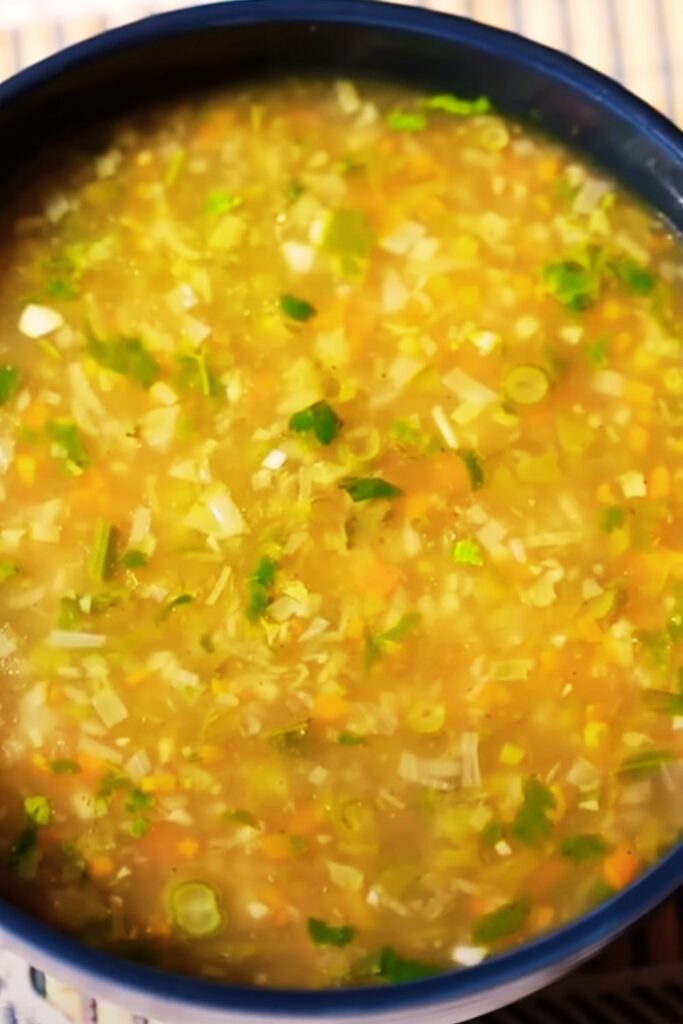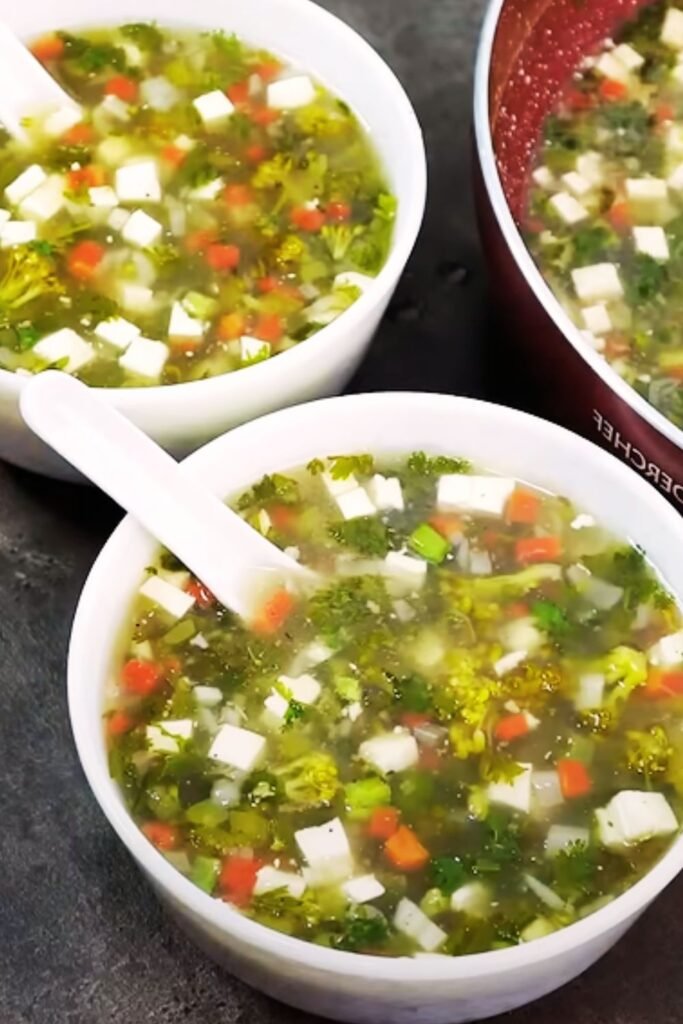There’s something magical about a bowl of lemon coriander soup that speaks directly to both body and soul. I discovered this vibrant, healing soup years ago when battling a particularly stubborn cold, and it’s remained a staple in my kitchen ever since. The bright citrus notes of lemon dance perfectly with the distinctive aroma of fresh coriander (cilantro), creating a soup that’s both invigorating and comforting.
This isn’t just any ordinary soup—it’s a powerful immunity booster packed with vitamin C and antioxidants that can help ward off seasonal illnesses. But beyond its health benefits, this soup delivers a flavor profile that’s simultaneously zesty, herbaceous, and soothing. Whether you’re feeling under the weather or simply craving something light yet satisfying, my foolproof lemon coriander soup recipe is exactly what you need.
The Magic of Lemon and Coriander Combined
Before diving into the recipe, let’s explore why these two star ingredients create such culinary magic when paired together.
Lemons offer that distinctive tanginess that awakens the palate, while also providing essential vitamin C and antioxidants. The bright acidity cuts through other flavors, creating balance and depth in what might otherwise be a simple vegetable broth.
Coriander (or cilantro) brings its unmistakable fresh, citrusy, and slightly peppery profile. The herb contains beneficial compounds like linalool and geranyl acetate that give it its characteristic aroma and flavor profile. While some people experience coriander as soapy due to genetic factors, for most, it adds an irreplaceable earthy-citrus note that perfectly complements the lemon.
When these two ingredients join forces, they create a flavor harmony that’s greater than the sum of its parts—bright, fresh, and incredibly aromatic. The combination stimulates the palate while the warmth of the soup soothes the throat and body.
Health Benefits That Will Surprise You
This isn’t just a delicious soup—it’s practically medicine in a bowl. Here’s why I make this regularly, especially during cold and flu season:
- Immune Support: The vitamin C from lemons helps boost your immune system function
- Anti-inflammatory Properties: Coriander contains compounds that may help reduce inflammation
- Digestive Aid: Both lemon and coriander support healthy digestion
- Detoxification: The combination helps stimulate liver function and natural detoxification
- Hydration: The clear broth helps maintain proper hydration, especially important when fighting illness
I’ve found that having a bowl of this soup when feeling the first signs of a cold can sometimes help prevent it from developing fully. There’s scientific backing to this as well—the steam helps clear congestion, while the nutrients support immune function.
Ingredients You’ll Need
For a soup that serves 4-6 people, here’s everything you’ll need:
For the Base:
- 2 tablespoons olive oil or ghee
- 1 medium onion, finely chopped
- 3-4 cloves garlic, minced
- 1-inch piece ginger, grated
- 1-2 green chilies, finely chopped (adjust according to heat preference)
- 2 medium carrots, diced into small cubes
- 1 stalk celery, finely chopped
- 6 cups vegetable broth (low sodium preferred)
- 1 teaspoon ground coriander seeds
- 1/2 teaspoon turmeric powder (optional but recommended)
- Salt and freshly ground black pepper to taste
For the Final Touch:
- Juice of 2-3 fresh lemons (approximately 4-6 tablespoons, adjust to taste)
- 1 cup fresh coriander leaves and tender stems, roughly chopped, plus extra for garnish
- 1 tablespoon cornstarch mixed with 2 tablespoons water (optional, for thickening)
Optional Add-ins for Protein:
- 1 cup shredded rotisserie chicken
- 1 cup small cubed tofu
- 1 cup cooked quinoa
- 1 cup cooked and shredded chicken breast
Equipment Needed
You don’t need fancy tools to make this wonderful soup:
- Large soup pot or Dutch oven
- Cutting board and sharp knife
- Wooden spoon or heat-resistant spatula
- Citrus juicer or reamer
- Measuring cups and spoons
- Ladle for serving
Step-by-Step Preparation

1. Prepare the Base
- Heat olive oil or ghee in a large pot over medium heat.
- Add the finely chopped onions and sauté until translucent, about 3-4 minutes.
- Add the minced garlic, grated ginger, and chopped green chilies. Cook for another 1-2 minutes until fragrant, being careful not to burn the garlic.
- Stir in the ground coriander seeds and turmeric powder (if using). Let the spices toast for about 30 seconds to release their flavors.
2. Build the Soup
- Add the diced carrots and celery to the pot. Sauté for 3-4 minutes until they begin to soften slightly.
- Pour in the vegetable broth and bring the mixture to a boil.
- Once boiling, reduce the heat to low, cover partially with a lid, and let the soup simmer for about 15-20 minutes until the vegetables are tender.
- Season with salt and freshly ground black pepper to taste.
3. Finish with Fresh Elements
- When the vegetables are tender, if you prefer a slightly thicker consistency, stir in the cornstarch slurry (cornstarch mixed with water) while the soup is simmering. Cook for an additional 2 minutes until the soup thickens slightly.
- Turn off the heat and let the soup cool for about 2-3 minutes.
- Stir in the fresh lemon juice, starting with juice from two lemons, then taste and add more if desired.
- Add the chopped fresh coriander leaves and stems, reserving some for garnish.
- If adding any protein options, fold them in now.
4. Serve with Love
Ladle the hot soup into bowls and garnish with additional fresh coriander leaves and a small lemon wedge if desired. The soup should be served immediately while hot for maximum flavor and benefit.
Variations to Keep Things Interesting
One of the reasons I love this soup so much is its versatility. Here are some of my favorite variations that I’ve developed over the years:
Thai-Inspired Version
Add a tablespoon of Thai red curry paste when sautéing the aromatics and finish the soup with a splash of coconut milk and a tablespoon of fish sauce for a Thai-inspired twist.
Indian-Influenced Version
Incorporate 1 teaspoon of cumin seeds and 1/4 teaspoon of asafoetida when sautéing the onions. Add 1/2 teaspoon of garam masala at the end for an Indian-influenced flavor profile.
Heartier Meal Version
Add 1/2 cup of red lentils with the broth and simmer until they’re soft and partially dissolved, creating a more substantial soup with added protein and fiber.
Spring Detox Version
Add 2 cups of chopped spinach or kale in the last 3-4 minutes of cooking for added nutrients and a beautiful green color.
Nutrition Information
For those who like to keep track of nutritional values, here’s a breakdown of what you can expect per serving (approximately 1.5 cups) of the basic recipe without add-ins:
| Nutrient | Amount per Serving |
|---|---|
| Calories | 95-110 |
| Protein | 2g |
| Carbohydrates | 14g |
| Dietary Fiber | 3g |
| Sugars | 5g |
| Fat | 4g |
| Saturated Fat | 0.5g |
| Vitamin C | 45% DV |
| Vitamin A | 70% DV |
| Potassium | 12% DV |
| Sodium | 650mg (varies with broth) |
Storage and Reheating Tips
I often make a large batch of this soup to enjoy throughout the week. Here’s how I store and reheat it to maintain its quality:
Storage:
- Refrigerator: The soup will keep well in an airtight container for up to 4 days.
- Freezer: For longer storage, freeze in portion-sized containers for up to 3 months.
Reheating:
- Stovetop: Reheat gently over medium-low heat, stirring occasionally. Add a splash of water if the soup has thickened too much during storage.
- Microwave: Heat on 70% power in 1-minute intervals, stirring between each interval until hot.
Pro tip: When freezing, I leave out the fresh coriander and lemon juice, adding fresh portions when reheating for the brightest flavor.
Serving Suggestions

This versatile soup pairs beautifully with various accompaniments:
- Bread Options: Serve with warm naan, crusty sourdough, or buttery garlic bread for dipping
- Grain Sides: A small portion of steamed basmati rice or quinoa adds substance
- Fresh Elements: A simple side salad with cucumber and cherry tomatoes provides textural contrast
- Protein Additions: A boiled egg halved on top or a dollop of Greek yogurt adds protein
- Crispy Toppings: Toasted pumpkin seeds or crispy fried onions add delightful crunch
For a complete meal, I often serve smaller portions of the soup as a starter, followed by a light main course like a chickpea salad or grilled fish.
Special Dietary Adaptations
One of the reasons this soup has remained popular with friends and family is how easily it adapts to different dietary needs:
Gluten-Free
The basic recipe is naturally gluten-free. Just ensure your vegetable broth is certified gluten-free if serving to someone with celiac disease.
Vegan/Vegetarian
The recipe as written is vegan and vegetarian. If using ghee instead of olive oil, replace with coconut oil to maintain vegan status.
Low-Carb
The soup is naturally low in carbohydrates. Skip the cornstarch thickener for an even lower carb count.
Keto-Friendly
Replace the carrots with lower-carb vegetables like zucchini or more celery, and skip the cornstarch thickener.
Common Mistakes to Avoid
Through years of making this soup, I’ve identified some common pitfalls:
- Adding lemon juice too early: Never add lemon juice during the cooking process—the heat will make it bitter and diminish the bright flavor. Always add it after turning off the heat.
- Overcooking the coriander: Similar to lemon juice, fresh coriander should be added at the end. Cooking it too long destroys its vibrant flavor and aroma.
- Under-seasoning: This soup needs adequate salt to make the flavors pop. Season in stages and taste as you go.
- Using bottled lemon juice: For the best flavor, always use freshly squeezed lemons rather than bottled juice, which often has preservatives and a flat taste.
- Cutting vegetables inconsistently: Try to dice vegetables to a uniform size for even cooking.
Seasonal Adaptations
I adjust this soup throughout the year to make the most of seasonal produce:
Spring/Summer Version: I add fresh peas, asparagus tips, or zucchini, and use more herbs like mint or basil alongside the coriander.
Fall/Winter Version: I incorporate heartier elements like sweet potatoes, kale, or even a small amount of pumpkin, and increase the warming spices slightly.
The Power of Presentation

Even the simplest soup can become impressive with thoughtful presentation:
- Serve in warmed bowls to keep the soup hot longer
- Create a small “island” of fresh coriander leaves in the center
- Add a light drizzle of good olive oil on top for richness and visual appeal
- Include a thin slice of lemon floating on top
- For special occasions, a few edible flowers like nasturtiums make an elegant garnish
Q&A Section
Q: Can I make this soup if I’m one of those people who thinks cilantro (coriander) tastes like soap?
Absolutely! This genetic predisposition affects about 14-21% of people. You can substitute the fresh coriander with flat-leaf parsley, mint, or basil. The ground coriander seed in the recipe doesn’t typically trigger the “soapy” taste reaction, so you can keep that in.
Q: Is this soup good for colds and flu?
In my experience, yes! The combination of vitamin C from the lemons, anti-inflammatory compounds from the coriander, and warm broth can be very soothing when you’re under the weather. The steam also helps clear congestion, and the soup provides easy-to-digest nutrition and hydration when your appetite might be low.
Q: Can I make this in an Instant Pot or slow cooker?
Definitely! For Instant Pot, use the sauté function for the initial steps, then pressure cook on high for 3 minutes with natural release. For slow cooker, sauté the aromatics separately first, then combine everything except lemon juice and fresh coriander in the slow cooker. Cook on low for 4-5 hours or high for 2-3 hours, adding the lemon juice and fresh herbs just before serving.
Q: How can I make this soup more filling for a main meal?
Add protein like shredded chicken, diced tofu, cooked quinoa, or white beans. You can also serve it with a substantial side like a grilled cheese sandwich or avocado toast to make it more filling.
Q: My soup turned bitter. What happened?
The most common cause of bitterness is adding the lemon juice while the soup is still cooking at high heat. Always add lemon juice after turning off the heat. Another potential cause is using too much of the coriander stems, which can be more bitter than the leaves. Lastly, check if your lemons have bitter white pith included with the juice.
Q: Can I use dried coriander leaves instead of fresh?
I don’t recommend it. Dried coriander leaves have a very different flavor profile from fresh and don’t provide the same bright, citrusy notes that make this soup special. If fresh isn’t available, it’s better to substitute with another fresh herb like parsley.
Q: How spicy is this soup?
The basic recipe has a very mild heat from the green chilies. You can adjust the spice level by removing the seeds from the chilies (for less heat) or adding more chilies or even a pinch of red pepper flakes (for more heat).
Q: What’s the best way to juice lemons for this recipe?
Roll the lemons firmly on the counter before cutting to help release more juice. Use a handheld citrus reamer or squeeze by hand while catching seeds with your other hand. Room temperature lemons yield more juice than cold ones.
Why This Soup Has Become My Kitchen Staple
I’ve shared this recipe with countless friends over the years, and it’s always met with requests for seconds. There’s something universally appealing about the clean, bright flavors combined with the comforting warmth of soup. It’s light enough to serve as a starter yet can be substantial enough for a main course with the right additions.
What I love most is how this soup adapts to any occasion—it’s elegant enough for entertaining yet simple enough for a quick weeknight dinner. It transitions seamlessly through seasons with minor adjustments, always delivering big on flavor with minimal effort.
Whether you’re cooking to nourish a loved one who’s feeling under the weather, looking for a light meal after holiday indulgences, or simply craving something wholesome and delicious, this lemon coriander soup delivers every time. Give it a try, and I’m confident it will earn a permanent place in your recipe collection just as it has in mine.